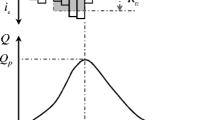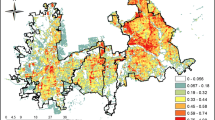Abstract
This paper is concerned with the estimation of aggregated direct runoff from small watersheds during a time interval (0,t), homogeneous with respect to rainfall characteristics. The storm events are simulated by a Poisson process, whereas direct runoff is estimated by the SCS method or a linear regression model. The probability of the occurrence of direct runoff is incorporated in the proposed method by examining the possibility of each storm exceeding the watershed losses index. A closed form solution is derived for the expected total direct runoff in the interval (0,t). Finally, the proposed method is applied to a particular set of conditions.
Similar content being viewed by others
Abbreviations
- Q :
-
direct runoff
- P :
-
rainfall depth
- S :
-
index of watershed storage
- CN:
-
Curve Number of SCS method
- t :
-
time
- T i :
-
time interval between successive storm events (i andi+1)
- X i :
-
storm depth of theith event (case a) excess storm depth of theith event (case b)
- Y(t) :
-
total direct runoff in (0,t)
- N(t) :
-
number of storm events in (0,t)
- F(t) :
-
distribution function of the time between storm events
- G(x) :
-
distribution function of the storm depth
- F n(t),F n+1(t):
-
n-fold and (n+1)-fold convolution ofF(t), respectively
- G n(x),G n+1(x):
-
n-fold and (n+1)-fold convolution ofG(x), respectively
- E[X] :
-
expected mean value
- p :
-
probability of exceeding the thresholde,p+q=1
- *:
-
convolution operation
References
Chong, S. K. and Teng, T. M., 1986, Relationship between the runoff curve number and hydrological soil properties,J. Hydrol. 8, 1–7.
Eagleson, P., 1978, Climate, soil and vegetation, 2. The distributions of annual precipitation derived from observed storm sequences,Water Resour. Res. 14(5), 713–721.
McConalogue, D. J., 1978, Convolution integrals involving distribution functions (Algorithm 102),Computer J. 21, 270–272.
Hawkins, R. H., 1979, Runoff curve numbers from partial area watersheds.J. Irrig. Drain. Div., ASCE 105 (IR4), 375–389.
Ross, S. M., 1970,Applied Probability Models with Optimization Applications, Holden Day, New York.
Soil Conservation Service, 1972,National Engineering Handbook, Section 4: Hydrology. USDA, U.S. Government Printing Office, Washington, D.C.
Todorovic, P. and Woolhiser, D. A., 1976, Stochastic structure of the local pattern of precipitation, in H. W. Shen (ed.),Stochastic Approaches to Water Resources, Vol. 2, Fort Collins, Colo. 15.1–15.37.
Todorovic, P. and Yevjevich, V., 1969, Stochastic process of precipitation. Hydrol. Paper 35, Colo. State Univ., Fort Collins.
Tsakiris, G., Agrafiotis, G., and Kiountouzis, E., 1984, Modelling the occurrence of wet and dry periods, in G. Tsakiris (ed.),Proceedings of the 5th Inter. Conf. on Water Resources Planning and Management, subject 5, 5.121–5.135, Athens, Greece.
Waymire, E. and Gupta, V., (1981), The mathematical structure of rainfall representations, 1. A Review of the stochastic rainfall models,Water Resour. Res. 17(5), 1261–1272.
Author information
Authors and Affiliations
Rights and permissions
About this article
Cite this article
Tsakiris, G., Agrafiotis, G. Aggregated runoff from small watersheds based on stochastic representation of storm events. Water Resour Manage 2, 77–86 (1988). https://doi.org/10.1007/BF00577061
Received:
Accepted:
Issue Date:
DOI: https://doi.org/10.1007/BF00577061




